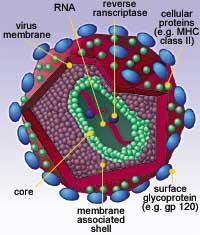 |
Discovery of Viruses
- Beijerinck (1897) coined the Latin name "virus" meaning poison for the substance infecting tobacco plants
- Wendell Stanley (1935) crystallized sap from tobacco leaves infected with Tobacco Mosaic Virus (TMV) & found virus was made of nucleic acid & protein
 |  |
| Wendell Stanley | Tobacco Leaf with Virus |
- Edward Jenner developed smallpox vaccine using milder cowpox viruses
- Virology - study of viruses
- Deadly viruses are said to be virulent
- Viruses couldn't be seen until electron microscope invented
Viral Characteristics
- Not living organisms
- Noncellular
- Consist of a nucleic acid core (DNA or RNA) and a protein coat called the capsid
- Capsid made of protein subunits called capsomeres
- Cannot grow or replicate on their own (inactive particles)
 |  |
- Can only reproduce inside of a living host cell using its raw materials & enzymes
- Lack ribosomes & enzymes needed for protein synthesis or metabolism
- Are extremely small particles ranging from 20 - 400 nanometers on average
- Largest virus is 1000 nanometers in dimension
- Some can cause disease (smallpox, measles, mononucleosis, influenza, colds, AIDS, Ebola

Ebola Virus
- Some may also cause cancers such as leukemias
- Virus free cells are rare
- Highly host specific (only infect certain cells)
- Referred to as phages
- Viruses are classified into 2 main groups by their nucleic acid --- DNA or RNA Viruses
- DNA & RNA viruses are subdivided by capsid shape & whether they do or don't have an envelope
Viral Structure
- DNA or RNA core surrounded by protein sheath called capsid
- Nucleocapsid includes the viral nucleic acid & its capsid
- Some form lipid rich covering around capsid called the envelope
- Envelope usually formed from host cell membrane
- Envelope may have spikes to help chemically recognize & attach to the host cell
- Shaped determined by the arrangement of proteins making up the capsid
- TMV is rod shaped

- Adenovirus & polio viruses are icosohedral (20 sided)

- Measles & rabies viruses are helical
- T -phages have a head & tail

Bacteriophages or T-Phages
- Among the most complex viruses
- Attack bacterial cells
- Composed of a icosohedral head, tail, base plate, & tail fibers
- Long DNA molecule is inside the head
- Tail helps inject the viral DNA into host cell
- Tail fibers used to attach to host
Retroviruses
- Contain RNA
- Have an enzyme called reverse transcriptase which helps use the RNA to make DNA
- Use the host cell's ribosomes & raw materials to make viral proteins
- Cause some cancers & AIDS

HIV Virus
Viroids
- Smallest particle able to replicate
- Made of a short, single strand of RNA with no capsid
- Cause disease in plants

Viroid Attack on Potatoes
Prions
- No nucleic acid or capsids
- Made of protein particles that have folded incorrectly
- Attacks the central nervous system
- Cause animal diseases in cows (Mad Cow disease), sheep, & humans

Lytic Cycle
- Viral replication that rapidly kills the host cell causing it to lyse or burst
- Involves 5 steps ----- Adsorption, Injection, Replication, Assembly, & Lysis
- Adsorption --- phage attaches to cell membrane of host
- Injection --- nucleic acid (DNA) of virus injected into host cell
- Replication --- viral DNA inactivates host cell's DNA & uses host's raw materials & ribosomes to make viral DNA, capsids, tails, etc.
- Assembly --- new viral parts are combined to make new phages
- Lysis --- enzymes weaken & destroy the cell membrane causing it to lyse releasing new viruses that infect other cells
Phases of the Lytic Cycle of a Virulent Virus:
|
 Source: http://science.howstuffworks.com/virus-human.htm
Source: http://science.howstuffworks.com/virus-human.htm
Lysogenic Cycle
- Replication in which the virus stays inactive inside of the host cell & doesn't immediately kill it
- Viruses are called temperate phages
- Lysogenic steps include adsorption, injection, recombination, cell reproduction, activation, replication, assembly, & lysis
- Recombination ---Viral DNA joins with host cell DNA forming an inactive prophage
- Host cell reproduces normally until activated by an external stimuli
- External stimuli unknown, but could be ultraviolet radiation, carcinogens, etc.
- Once activated, prophage forms new viruses & destroys host cell
- HIV is an example of a temperate phage
The Lysogenic Cycle of a Temperate Virus:
|
 Source: http://science.howstuffworks.com/virus-human.htm
Source: http://science.howstuffworks.com/virus-human.htm
Viral Control
- Interferon are proteins made by cells to fight viruses
- Two types of viral vaccines exist --- inactivated & attenuated
- Inactivated virus vaccines don't replicate in the host's system
- Attenuated viral vaccines have been genetically altered so they can't cause disease
- Antiviral drugs (AZT, acyclovir, & azidothymidine) interfere with viral DNA synthesis
- Protease Inhibitors interfere with viral capsid production
- New viruses emerge as rain forests are cleared (Ebola virus)
- PUBLISHED BY
 |
| KABIR HUSSAIN BAIG |


No comments:
Post a Comment